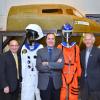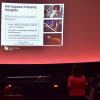Science & Technology
 <p>As Colorado’s climate continues to warm, those who manage or use water in the state will likely face significant changes in water supply and demand, according to a <a href="http://wwa.colorado.edu/climate/co2014report/">new report on state climate change</a> released today by the Western Water Assessment and the Colorado Water Conservation Board.</p>
<p>As Colorado’s climate continues to warm, those who manage or use water in the state will likely face significant changes in water supply and demand, according to a <a href="http://wwa.colorado.edu/climate/co2014report/">new report on state climate change</a> released today by the Western Water Assessment and the Colorado Water Conservation Board.</p> <p>Sierra Nevada Corporation’s (SNC) Space Systems is pleased to announce it is expanding its relationship with the University of Colorado Boulder through the signing of a letter of cooperation with CU-Boulder’s BioServe Space Technologies (BioServe). Through the cooperation, SNC and BioServe will jointly explore ways the <em>Dream Chaser</em>® Space Utility Vehicle (SUV) can serve as an orbital platform for scientific experiments in microgravity and space life science research.</p>
<p>Sierra Nevada Corporation’s (SNC) Space Systems is pleased to announce it is expanding its relationship with the University of Colorado Boulder through the signing of a letter of cooperation with CU-Boulder’s BioServe Space Technologies (BioServe). Through the cooperation, SNC and BioServe will jointly explore ways the <em>Dream Chaser</em>® Space Utility Vehicle (SUV) can serve as an orbital platform for scientific experiments in microgravity and space life science research.</p>- <p>Sierra Nevada Corp. news release</p>
<p>Sierra Nevada Corporation’s (SNC) Space Systems is pleased to announce it is expanding its relationship with the University of Colorado Boulder (CU-Boulder) through the signing of a letter of cooperation with CU-Boulder’s BioServe Space Technologies (BioServe). Through the cooperation, SNC and BioServe will jointly explore ways the <em>Dream Chaser</em>® Space Utility Vehicle (SUV) can serve as an orbital platform for scientific experiments in microgravity and space life science research.</p>  <p>Members of the Boulder Chamber, a nonprofit business support and advocacy organization, visited CU-Boulder July 29 to learn about the university’s latest advances in space science and aerospace.</p>
<p>Members of the Boulder Chamber, a nonprofit business support and advocacy organization, visited CU-Boulder July 29 to learn about the university’s latest advances in space science and aerospace.</p>
<p>The Aerospace Industry Insights event, held at Fiske Planetarium, brought together local, state and federal officials; CU-Boulder faculty, students and administrators; and leaders from the local business community. The purpose of the event, the first in a series sponsored by CU-Boulder and the Boulder Chamber, was to highlight for the business community CU-Boulder's research and innovation in order to foster continued partnership and economic growth.</p> <p>Three of the 62 scientists from around the world elected this week as American Geophysical Union Fellows are from the University of Colorado Boulder, tying the university for the most fellows elected in 2014 with the Woods Hole Oceanographic Institution in Massachusetts and Oregon State University in Corvallis.</p>
<p>Three of the 62 scientists from around the world elected this week as American Geophysical Union Fellows are from the University of Colorado Boulder, tying the university for the most fellows elected in 2014 with the Woods Hole Oceanographic Institution in Massachusetts and Oregon State University in Corvallis.</p>
<div>
The CU-Boulder honorees include Professor Anne Sheehan of the Department of Geological Sciences, Professor Shijie Zhong of the Department of Physics and Senior Research Associate Tom Woods of the Laboratory for Atmospheric and Space Physics. </div> <p>Ruth Ellen Kocher, professor of English and director of the creative writing program at the University of Colorado Boulder, has won a prestigious PEN Literary Award.</p>
<p>Ruth Ellen Kocher, professor of English and director of the creative writing program at the University of Colorado Boulder, has won a prestigious PEN Literary Award.</p>
<p>Kocher was a co-winner of the PEN Open Book Award for her book of poems titled <em>domina Un/blued.</em> The award recognizes an exceptional book-length work of literature by an author of color. Also winning the award was Nina McConigley for <em>Cowboys and East Indians</em>.</p> <p>A program designed at the University of Colorado Boulder to teach kids to code using video games is being introduced into New York City public schools as part of an initiative to give every student access to computer science education.</p>
<p>A program designed at the University of Colorado Boulder to teach kids to code using video games is being introduced into New York City public schools as part of an initiative to give every student access to computer science education.</p>
<p>Scalable Game Design is a program developed over two decades by CU-Boulder computer science Professor Alexander Repenning to spark an interest in coding among kids by allowing them to design and build their own video games. The idea behind the program, which uses drag-and-drop programming tools, is to combat the widely held notion that computer programming is hard and boring.</p> <p>Everyone has heard about the harmful effects of pollution on human and plant health, but until recently, visualizing such effects took some imagination.</p>
<p>Everyone has heard about the harmful effects of pollution on human and plant health, but until recently, visualizing such effects took some imagination.</p> <p>Playing in schoolyards that feature natural habitats and trees and not just asphalt and recreation equipment reduces children’s stress and inattention, according to a University of Colorado Boulder study.</p>
<p>Playing in schoolyards that feature natural habitats and trees and not just asphalt and recreation equipment reduces children’s stress and inattention, according to a University of Colorado Boulder study.</p> <p>Coming up in the CU-Boulder’s <a href="http://atlas.colorado.edu/wordpress/?page_id=542" target="_blank">ATLAS Black Box Theater</a> is <a href="http://squareproducttheatre.org/" target="_blank">square product theatre’s</a> production of "SLAB," an adaptation of Denver writer Selah Saterstrom’s forthcoming novel. The story is about a woman’s life in the American South told through her memories and from the slab of her post-Katrina home.</p>
<p>Coming up in the CU-Boulder’s <a href="http://atlas.colorado.edu/wordpress/?page_id=542" target="_blank">ATLAS Black Box Theater</a> is <a href="http://squareproducttheatre.org/" target="_blank">square product theatre’s</a> production of "SLAB," an adaptation of Denver writer Selah Saterstrom’s forthcoming novel. The story is about a woman’s life in the American South told through her memories and from the slab of her post-Katrina home.</p>


